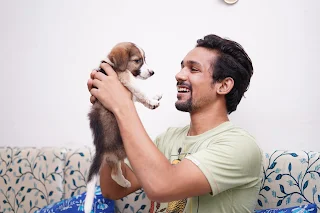When you get a new puppy, the most frustrating thing you will be faced with is teaching the baby to go potty outside and not in the house. Puppies don't have a clue about houses and rules. In the wild, their mother would teach them the place to relieve themselves; but your baby doesn't have that option. You, then, need to step up and teach that baby where to go without anger and without pain. There are definable steps you need to take if you want to make this a success and help your puppy learn to live with the family inside the house.
We've explored this topic before along with other training issues here, Essential Training for Your Pets.
Let's look at these steps in order:
Establish a Consistent Schedule
A predictable routine is key to successful house training. Feed your puppy on a set schedule, which will help you anticipate when they'll need to go outside. Most puppies need to eliminate after eating, waking up, and playing.
Additionally, consider where your puppy sleeps. A small wire crate next to your bed is ideal. This not only helps with house training but also strengthens the bond between you and your pup. For daytime activities, a larger crate in the area where you spend the most time can be beneficial.
Utilize the Crate Effectively
A crate is not just a containment tool; it's a valuable asset in housebreaking. Dogs naturally avoid soiling their sleeping areas. Ensure the crate is appropriately sized – your puppy should be able to stand up, turn around, and lie down comfortably, but not have so much space that they can eliminate in one corner and sleep in another.
Learn Your Puppy's Signals
Just as humans show signs when they need to use the restroom, so do puppies. Common cues include sniffing around, circling, or showing restlessness. By identifying these signals early on, you can preemptively take your puppy outside before an accident occurs. This can only be successful if you are consistent and watchful, so if you cannot watch your pet, be sure to crate him until you are able to be mindful of his needs.
Address Accidents the Right Way
Accidents will happen. When they do, it's crucial to clean them up promptly using an enzymatic cleaner. This type of cleaner breaks down the molecules in urine and feces, eliminating the scent and reducing the chance your puppy will return to the same spot.
Remember, punishing a puppy for accidents is counterproductive. Instead, focus on prevention and positive reinforcement.
Embrace Positive Reinforcement
Every time your puppy does their business outside, celebrate the achievement! Praise them enthusiastically and consider giving them a treat. This positive reinforcement will help them associate going outside with rewards, making them more likely to wait to be let out in the future.
Consistency is Key: Use Verbal Cues and Designated Areas
Select a specific phrase, like "Go potty," and use it consistently every time you take your puppy outside. This verbal cue will help them understand what's expected. Additionally, choose a designated potty area in your yard. Over time, your puppy will learn that this is their bathroom spot.
How Long Does House Training Take?
The duration of the housebreaking process can vary. While most puppies can be fully housebroken by 4-6 months of age, some might take longer. The key is to remain patient and consistent.
How Often Should Puppies Go Out?
According to experts, puppies should be taken outside at least every two hours. This frequency increases after activities like playing, eating, or drinking. As your puppy matures, they'll be able to hold it in for longer periods.
House training your puppy is a journey that requires dedication, patience, and love. By following these steps and understanding your puppy's needs, you'll create a harmonious living environment for both of you.
Sources:
(1) How to Housebreak Your Puppy in 5 Steps - The Spruce Pets. https://www.thesprucepets.com/about-how-to-housebreak-your-puppy-2804690.
(2) 7 Best Tips on How to Housebreak a Puppy - Wag!. https://wagwalking.com/daily/7-best-tips-on-how-to-housebreak-a-puppy.
(3) 7 Trainer-Approved Tips for Housebreaking a Puppy - Vetstreet. https://www.vetstreet.com/our-pet-experts/7-trainer-approved-puppy-housebreaking-tips.
(4) Housebreaking a Puppy or Older Dog in 6 Steps. https://www.dogingtonpost.com/housebreaking-a-puppy-or-older-dog-in-6-steps/.
(5) How to housebreak your Labrador puppy - Otter Tail Kennels. https://ottertailkennels.com/house-break-puppy/.
(6) How to Housebreak Your Puppy in 5 Steps - The Spruce Pets. https://www.thesprucepets.com/about-how-to-housebreak-your-puppy-2804690.
(7) How Long Does it Take to House Train a Puppy? | Canna-Pet®. https://canna-pet.com/articles/long-take-house-train-puppy/.
(8) What Is the Average Time for Housebreaking a Puppy?. https://www.cuteness.com/article/average-time-housebreaking-puppy.



















